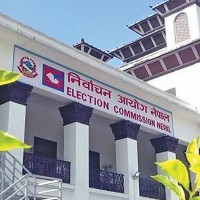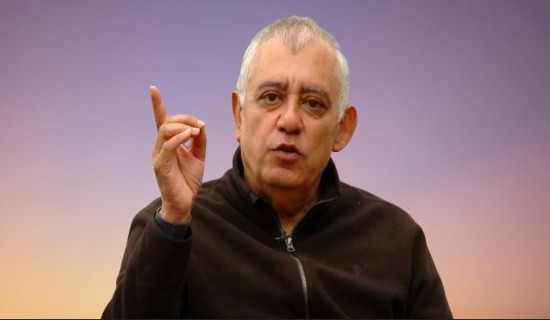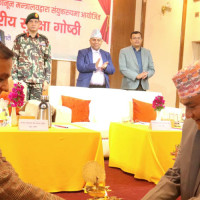- Tuesday, 2 December 2025
Health insurance scheme faces challenges
Kathmandu, May 12: It took around six years for the authorities to expand the National Health Insurance Programme in all 77 districts, and three more years to reach all 753 local levels.
Under that scheme, a family of up to five members needs to pay a premium of Rs. 3,500 annually to avail themselves of health services amounting up to Rs. 100,000.
Meanwhile, a family comprising more than five members must pay an additional Rs. 700 for each member and receive an additional insurance cover of Rs. 20,000.
The health insurance can be used for major as well as minor health services. For instance, the insurance covers the cost of the bed in the Intensive Care Unit (ICU), haemodialysis, surgeries, radiological investigations and ayurvedic treatment to medicines.
However, despite being hailed as one of the best initiatives of the government in the health sector, the National Health Insurance Programme has not been utilised to its best.
“The National Health Insurance Programme alone cannot benefit the citizens. It can be highly beneficial only if every local level has at least one quality health centre,” said Dr. Gunraj Lohani, Chairperson of the Health Insurance Board (HIB).
Dr. Lohani, who has also led the Department of Health Services (DoHS) and served as a high-level official at the Ministry of Health and Population over the years, stressed that the programme was not as effective as expected due to a lack of awareness among the service seekers and providers.
As per the HIB, one of the main aims of the health insurance programme was to provide financial protection to the citizens while reducing out-of-pocket spending (OOPS) and astronomical health expenditures which can push them towards poverty.
Compelled to visit capital
The counter for the Health Insurance Programme at Bir Hospital has been relocated to the new building from the premises of the old one. On Friday, the counter, which is operated by three employees, was crowded with patients opting for the health insurance programme.
After sitting in a line for at least an hour, an individual reaches in front of the counter. S/He then hands over the documents to the first employee who confirms the insured person. The insured person should then wait in another line where the second employee scans the documents of referral and others. Finally, after waiting in the third line, the third employee confirms the NMC License of the doctor and sends the service seeker to the Prabhu Bank counter for the final procedure.
The employees kept doing their work despite hundreds of patients scolding them for their slow pace and missing and misplacing documents in a hurry.
“A majority of individuals who come here are from outside the Kathmandu Valley. They are likely to get angry about the delays as they are patients who have come from far away. However, we cannot cater to such a large number of service seekers efficiently with so few employees,” said an employee at the health insurance counter of Bir Hospital as she left her seat for her colleague to eat her lunch at around noon since she had been working with an empty stomach since the counter opened at around 8 am.
As per the reports, the majority of the active insured persons, until 2022/23, are from Gandaki Province (26.6 per cent) followed by Koshi (26.3 per cent), Bagmati (17.8 per cent), Karnali (15.7 per cent), Lumbini (13.4 per cent), Sudurpashchim (13.1 per cent) and Madhes (5.1 per cent).
When the patients in the queue in Bir Hospital were asked about the reason for arriving in Kathmandu, they all echoed that the local, district and provincial health centres of their respective regions could not treat their illness.
“I have problems in my kidney and lungs. I first reached Kailali and then Dhangadhi before being referred to Kathmandu,” said Tilsari Sirpali, a 61-year-old from Pahalmanpur in Kailali district, who was begging for money inside and outside Bir Hospital.
Until Fiscal Year 2022/23, 463 health centres – 378 government, 52 private and 33 community – have been providing services under the Programme.
Unaware service seekers
Sirpali has been living alone after losing her husband and son. According to her, her property has been forcefully possessed by her relatives after she was left alone.
Sirpali informed she had nothing left with her and was now a poor individual. However, she has been paying the premium of her health insurance for the past three years by herself.
As per the Health Insurance Act, 2074, the government should pay the premium for senior citizens (70+), fully disabled individuals, MDR-TB, HIV patients and poor citizens.
“I have never been suggested that the government would pay the premium of a poor citizen. As I could not collect enough money for the premium this time, my renewal process was extended
by three months and my health insurance is not active now,” said Sirpali, adding, “In lack of the insurance, I have been forced to beg for my medicines.”
Moreover, Sirpali needs more than the annual premium amount of health insurance to reach her village for the renewal process and return to Kathmandu for treatment.
“I feel healthier than before after I was treated by the doctors in Kathmandu. It is all thanks to the health insurance programme that I could afford to be treated in the capital city. Meanwhile, it would be far better if I could avail such services in my own province,” Sirpali exclaimed.
While citizens like Sirpali are unaware of the benefits associated with the health insurance programme, many insured individuals misuse the programme due to a lack of awareness.
“When patients with a problem in their leg come to the hospital, they force us to prescribe tests for their head and other healthy parts of the body as well. Many want to take medicines for almost a year at once. They make such demands citing that they have health insurance and they are free to use it as they want,” said a doctor standing near the Health Insurance counter of Bir Hospital.
Such scenarios are what have led the HIB to enforce a new rule. Stating ‘provider and consumer side moral hazard’, the government and HIB have directed the insured persons to pay 10 per cent of the cost from their pocket while the remaining 90 per cent will be covered by health insurance. While an insured person should pay 10 per cent at a government health centre, they should pay 20 per cent at a private one.
“Some health centres have also hampered the healthy utilisation of the programme by sending unnecessary and immoral claims for money,” said Dr. Lohani.
Until 2022/23, the HIB received 7,558,443 claims and rejected 50,709 of them. The HIB has reimbursed Rs. 13,500,394,245 to 6,529,302 claims it accepted. The average amount per claim stands at Rs. 1,896.
Low renewal rate
A family should pay an annual premium to renew their health insurance and utilise it unhindered while the premium of the targeted groups is paid timely through the local government.
Until Fiscal Year 2022/23, 24.7 per cent of the total population, i.e. 7,215,098 individuals, were enrolled under the National Health Insurance Programme since the programme was initiated in 2016/17. However, of them, only 4,658,331 are active insures in 2022/23.
According to the HIB’s 2022/23 Annual Report, the renewal rate of the programme stands at 59 per cent.
“A person/family is not renewing their health insurance after finding that it was not beneficial for them. One of the major reasons behind it is the inability to utilise health insurance facility nearby,” said Dr. Lohani.
Way forward
According to health experts, the health insurance programme can be as effective as expected if the citizens and service providers follow moral ethics.
“Health insurance is a programme for the citizens to motivate them to visit the health centres, have timely check-ups and prevent severe illnesses,” said Dr. Lohani, adding, “It is possible and feasible if the insured persons can avail of those services at a nearby health centre.” Thus, the HIB stresses the importance of the operation of 5/10/15-bed hospitals at all local levels. “The health centre should, however, be able to provide basic tests and diagnosis with the help of specialised doctors and quality equipment,” Dr. Lohani said.
Moreover, the provincial governments have also been suggested to improve their hospitals and upgrade them into tertiary-level hospitals with specialised services.
“Health insurance is beneficial if a patient has an easy access to a quality health institution, doctors, treatment and medicines.
While the Board will now focus on enrolling the majority of the population under the scheme, we expect the other authorities to prepare sufficient health infrastructure,” said Dr. Lohani. Similarly, the HIB also seeks the support from the government in making it compulsory for government employees and security personnel to get enrolled under the Health Insurance Programme.

















